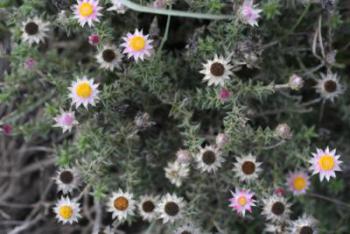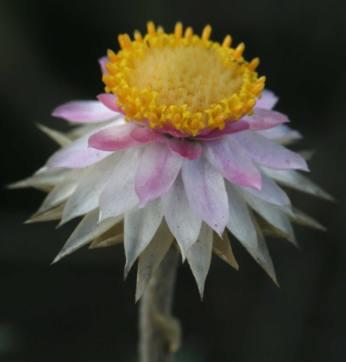Syncarpha recurvata
Syncarpha recurvata (L.f.) B.Nord.
Family: Asteraceae
Common names: None recorded.
Introduction
Syncarpha recurvata is a small, shrubby daisy with pretty pink flowerheads and attractive silvery foliage. This low shrub is endemic to a small area in the Eastern Cape. Unfortunately, its habitat is under threat and this beautiful little everlasting is fast losing the only places where it can exist naturally. There are none known common names for Syncarpha recurvata, but Syncarpha species in general are known as sewejaartjies (little seven-years) in Afrikaans, indicating that the flowers last for a long time, and echoing the English common name, everlasting, which is applied to many different species which last well as dried ornamental cut-flowers.

Description
Description
The plant is a low, well-branched shrub that forms small bushes in scrub on calcareous ridges. Stems are robust and about 120-300 mm high. The leaves are narrow and green and are curved backwards and covered in silky hairs, giving them a silvery appearance.

During the flowering period the bushes are topped by small but striking hemispherical flowerheads. The flowers are tiny and yellow, and are borne in rounded heads surrounded by dry, shiny, spreading pink bracts that become silvery with age. Each plant produces a fairly large number of flowerheads, forming an attractive display. The main flowering period appears to be early summer, but plants can be found in flower in April and other months.

Conservation Status
Status
This species is listed as Endangered according to the SANBI Red List (http://redlist.sanbi.org). At the time of assessment, eight severely fragmented subpopulations were thought to remain, and these were in decline due to calcrete mining for cement production, urban expansion, and alien plant invasion. Exploitation as everlasting cut-flowers may also pose a threat in populations that are easily accessible.
Conservation through relocation is the focus of ongoing studies by E.E.Campbell and students at the Nelson Mandela Metropolitan University.
Distribution and habitat
Distribution description
Syncarpha recurvata occurs in low-lying areas (from sea level up to 200 m altitude) in the Bontveld of the Eastern Cape. This vegetation covers only 500 km² and consists of a mosaic of bushclumps and grassveld. Within the Bontveld, S. recurvata is confined to shallow calcareous sands on calcrete ridges.

The climate in this area is oceanic, with mild cool winters and warm summers, and some degree of humidity. The temperature range is small, and so the plant might not tolerate frost. In addition, in its natural habitat S. recurvata does not experience a dry season, as precipitation is distributed throughout the year. However, rainfall is greater and more frequent during the winter months.

Derivation of name and historical aspects
History
Syncarpha is a genus of 28 species endemic to the Cape Floristic Region. In Greek, syn means united, and carphos, any small dry body; it is thought that the generic name might refer to the dry bracts which are united into a cone-like structure surrounding the flowerheads. The specific name, recurvata, refers to the leaves which are bent backwards (recurved). Several Syncarpha species are very showy and are attractive horticultural plants in indigenous gardens (for example, S. argentea and S. vestita). S. eximia (strawberry everlasting) is not cultivated but is an extremely striking member of the genus. S. vestita is known as 'Cape snow' and is a popular nature photography subject.
Ecology
Ecology
Little is known of the ecological interactions of Syncarpha recurvata. The beautiful flowerheads are likely to play a role in attracting an animal pollinator, but no record exists of who or what this pollinator might be.
Syncarpha seeds (called achenes or cypselae) are small and light, and bear a crown of feathery hairs (called a pappus) which is likely to aid in wind dispersal.
Syncarpha recurvata is highly specialised on a unique soil type which consists of ancient marine sediments compacted to form soft calcrete. This habitat-specificity is likely to be one of the factors that limits its distribution range, confining it to small areas where this soil type is exposed.
Uses
Use
The flowerheads of Syncarpha recurvata are exceptionally attractive and are commonly used as ornamental cut-flowers by members of the public. Since the colourful parts of the flowerhead consist of dry, papery bracts, they make good everlasting displays together with dried grasses.

Growing Syncarpha recurvata
Grow
Syncarpha recurvata is likely to make an extremely attractive high groundcover or border in lime-rich areas or special calcareous-soil sections of the garden. Alternatively, it could be grown in pots containing a mixture of calcareous soil and peat.
Although it is not currently commonly cultivated, the propagation of S. recurvata has been investigated in order to attempt ex situ conservation (Swart 2006). Several propagation methods were successful, but the recommended propagation method is air-layering.
For air-layering a 5 mm section of bark was removed from two to five healthy stems of each individual by Swart (2006). The section of the stem was then treated with 'Seradix© no.1' and covered with 50 ml of a 1:1 mixture of calcareous soil and coir secured to the stem with aluminium foil. After 4 weeks a 40% rooting success was recorded. Although this is a low percentage, a branch that did not root in air-layering can remain on the plant to attempt air-layering later, or to aid in additional growth of the mother plant. Air-layering is therefore less destructive and more sustainable than taking cuttings. This is an important fact to consider, as this is an endangered species.
For cuttings, rooting success was 50% after four weeks in the study by Swart (2006). Cuttings of 100 mm length were taken from the stems of healthy plants. Leaves from the lower 20 mm of the cutting were removed and treated with 'Seradix© no. 1'. Cuttings were placed in a 1:1 mixture of calcareous soil and coir. These cuttings were then placed in a humid environment to promote rooting (small misting tunnels were constructed for this by Swart (2006).
The plants can also be propagated from seed, although germination success is generally low (around 20%). Success is enhanced by sorting the seeds and choosing mature achenes (dark with a swollen appearance) harvested under dry conditions throughout winter. Seeds should be stored for several months to allow after-ripening, before attempting to germinate them.
References
- Swart, P.A. 2006. Horticultural propagation of the threatened species, Syncarpha recurvata (L.f.) B.Nord. Unpublished MSc. thesis, Faculty of Science, Nelson Mandela Metropolitan University.
- Trinder-Smith, T.H. 2003. The Levyns Guide to the plant genera of the Southwestern Cape. Contributions from the Bolus Herbarium No. 21.
Credits
Nicola Bergh
Comption Herbarium, Kirstenbosch
February 2013
Plant Attributes:
Plant Type: Ground Cover, Perennial, Shrub
SA Distribution: Eastern Cape
Soil type: Sandy, Loam
Flowering season: Late Summer
PH: Alkaline, Neutral
Flower colour: Pink, Cream
Aspect: Morning Sun (Semi Shade), Afternoon Sun (Semi Shade)
Gardening skill: Challenging
Special Features:
Horticultural zones









Rate this article
Article well written and informative
Rate this plant
Is this an interesting plant?
Login to add your Comment
Back to topNot registered yet? Click here to register.